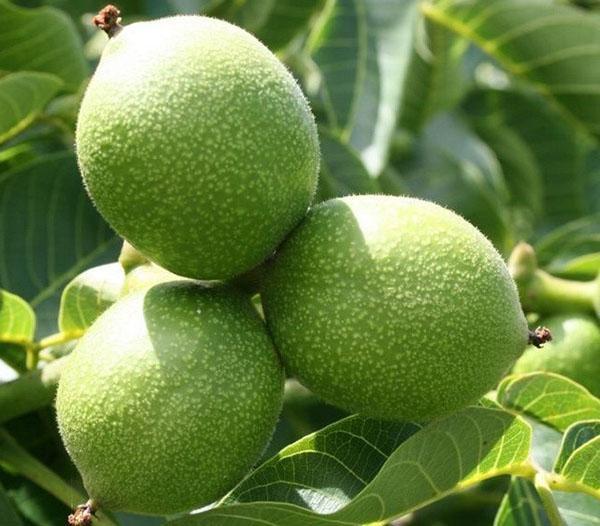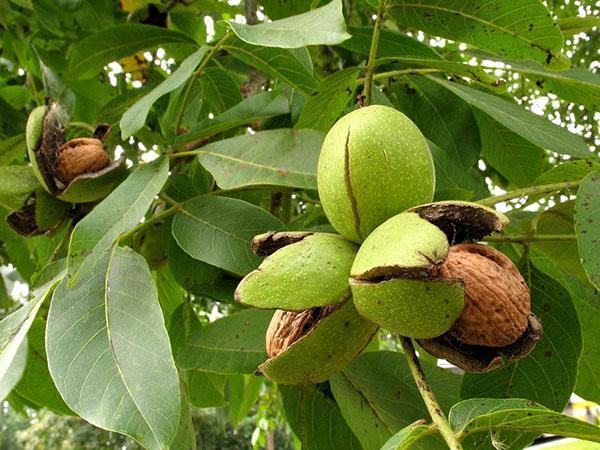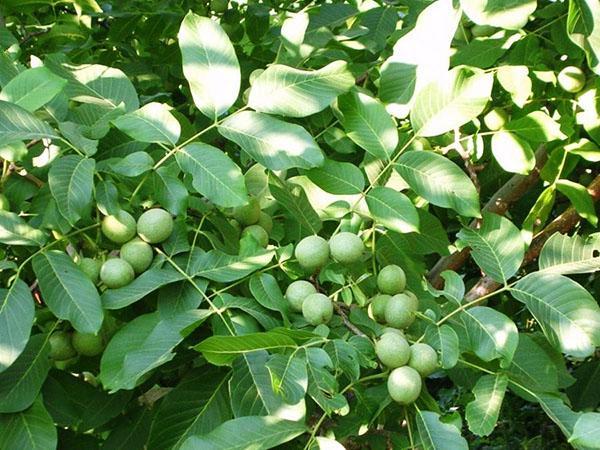Features of growing walnut varieties Ideal
 The Ideal walnut, bred in the middle of the last century, became one of the first Soviet varieties of this culture. The walnut trees traditionally cultivated in the southern regions yielded huge yields, amounting to hundreds of kilograms. But the varieties available to gardeners were very thermophilic, tall and grew for a long time before they reached the time of fruiting. New varieties were needed to expand the cultivation area for walnuts, simplify farming techniques and speed up harvesting.
The Ideal walnut, bred in the middle of the last century, became one of the first Soviet varieties of this culture. The walnut trees traditionally cultivated in the southern regions yielded huge yields, amounting to hundreds of kilograms. But the varieties available to gardeners were very thermophilic, tall and grew for a long time before they reached the time of fruiting. New varieties were needed to expand the cultivation area for walnuts, simplify farming techniques and speed up harvesting.
Scientists from the Uzbek SSR successfully coped with the task in 1947. In Fergana, breeders managed to get hardy early ripening plants with high yields and excellent quality of ripe nuts. Created by S.S. Kalmyk walnut variety The ideal for many gardeners is really close to perfection.
Description of walnut variety Ideal

Ideal differs from most southern varieties in high early maturity, short stature and increased frost resistance.
On average, mature trees reach only 4–5 meters in height, which is 1.5–2 times less than that of other varieties. The first ovaries on still young plants appear already 2-3 years after planting, and the Ideal walnut reaches a stable yield by 5-7 years.
As befits a walnut, the bark on the standard part of the trees has a pronounced grayish-brown hue. Skeletal branches and fruiting shoots are covered with brown bark, and the young growth is colored with green tones with a clear bluish bloom. The leaves of a valuable garden culture are large, dense, dissected into several unpaired, oval-pointed parts.
The first flowering of walnut seedlings Ideal occurs in the second or third year. In the same season, after the greenish-white small flowers collected in a brush are pollinated by the wind, the first ovaries form on the branches.
The peculiarity of the culture is dioecious flowers and the presence of a second wave of flowering, which in good years helps to get two crops of excellent nuts at once.
The re-emergence of flower clusters, according to the description of the Ideal walnut variety, begins 7-15 days after the first, most massive wave and does not end until autumn. If in spring the delicate flower buds are affected by frost, the gardener may not worry about the harvest. Not so abundant, but it will definitely be.
 Ripening of large, oval fruits, covered with a dense green shell, begins in September and lasts until the end of October. The average weight of a walnut Ideal is 8–11 grams. The shell of a light beige shade is quite thin. After drying, it breaks easily, releasing a kernel with excellent taste, high in protein and fat. From a large tree you can get up to 100-120 kg of selected nuts per season.
Ripening of large, oval fruits, covered with a dense green shell, begins in September and lasts until the end of October. The average weight of a walnut Ideal is 8–11 grams. The shell of a light beige shade is quite thin. After drying, it breaks easily, releasing a kernel with excellent taste, high in protein and fat. From a large tree you can get up to 100-120 kg of selected nuts per season.
 The advantages of the variety include:
The advantages of the variety include:
- early entry into the season of fruiting;
- decent yield;
- compact size;
- frost resistance, allowing walnuts tolerate winter temperatures up to 30–35 ° C without serious losses.
For planting walnuts Ideally no special potting mixes are needed. Plants are well acclimatized and grow on soil with a high content of salts and acids.
The only limitation that must be taken into account when transferring a seedling into the ground is the proximity of groundwater.They are highly undesirable for a walnut tree with a taproot structure.
Features of planting and growing walnut varieties Ideal
 The Ideal walnut is propagated by seeds and grafted seedlings for 1–2 years of life. The second method is preferable, since seedlings, although more unpretentious and hardy, do not always retain their parental features, especially if there was a possibility of cross-pollination from a plant of another variety.
The Ideal walnut is propagated by seeds and grafted seedlings for 1–2 years of life. The second method is preferable, since seedlings, although more unpretentious and hardy, do not always retain their parental features, especially if there was a possibility of cross-pollination from a plant of another variety.
If a walnut seedling is grown on the site, it should be grafted with a varietal cuttings. Kidney shots are less reliable due to the danger of freezing.
For sowing, healthy nuts are selected, which are preliminarily stratified for 30–45 days, and then, in spring or early autumn, are transferred into prepared soil. Young trees are also planted in spring or autumn, a month before the arrival of probable cold weather. In the first year of life, the Ideal walnut is very reluctant to grow, but after wintering it is very actively gaining in growth, reaching 1–1.3 meters in height by autumn.
 For planting, they choose a sunny area where the crowns of other crops will not interfere with the tree. A spreading tree already from the first year needs to be formed, which is carried out with the expectation that:
For planting, they choose a sunny area where the crowns of other crops will not interfere with the tree. A spreading tree already from the first year needs to be formed, which is carried out with the expectation that:
- each branch of the crown had enough sun;
- the whole crown was ventilated;
- pollination of flower brushes did not interfere with casting and inward growing shoots.
With proper care, the Ideal walnut pleases with high yields and a magnificent view from 40 to 50 years. This is somewhat less than that of its southern counterparts, but such is the price of the variety for its compactness and the possibility of growing even in the Black Earth Region, the Volga Region and central Russia.
I agree, but we propagate and sell walnut seedlings of the early-growing varieties Ideal and Kocherzhenko without grafting and the seedlings very well convey the qualities of the mother tree.
It's good that people rushed to plant a nut. So they start to take care of their FUTURE!
But we must bear in mind: we plant today, and in 6-8 years it will have to be from row spacings
absorb / uproot the seal crop, you will have to cut off 3-4 extra branches (which
hung on the ground / broken off / dried out). And if you plant 10-20 trees, and a whole hectare
(And more), then you need to go through a seminar / consultation (correct gardening with
taking into account the wind rose / soil in your area; fertilizer mycorrhizating
crop, which will increase the yield). Also keep in mind that many
nut sellers (90% are resellers: bought from farmers / breeders
- grew a 1-year-old - sold: good profit + minimum
responsibility / work; such do not conduct breeding work) will NOT show you
their mother trees. Recently, there are many serious walnut growers in Ukraine
guard their nut gardens with rifles! People, it's only on the internet that they say it
profitable. But few will tell you about the risks. Plant NOT imported
French / Moldovan / Turkish / Polish, and zoned, local varieties. This will
your reinsurance against late frosts (and hence small harvests). To that
calls on both D. Bondarenko and P. Tulba, as well as Novosad with
Volyn (had problems with Turkish seedlings). Rapid walnut varieties I. Kocherzhenko
and L. Shugin - were bred by pollination of imported Uzbek early-growing local
forms (respectively: Carpathian and Pyriatinsky). Also noteworthy is a new variety for Ukraine "int" from near Odessa (author A.K.
Ponomarenko) and nuts from the Cherkasy region / Champagne by Leonid Boyko (medium / tall).
Is a walnut of the ideal self-pollinated variety, or should another variety be planted next to it for pollination?
On the walnut tree there are flowers of the female and male type. Pollination occurs with the help of the wind.When several varieties are planted, mixing of plant characteristics can occur.
Natali thanks for the info